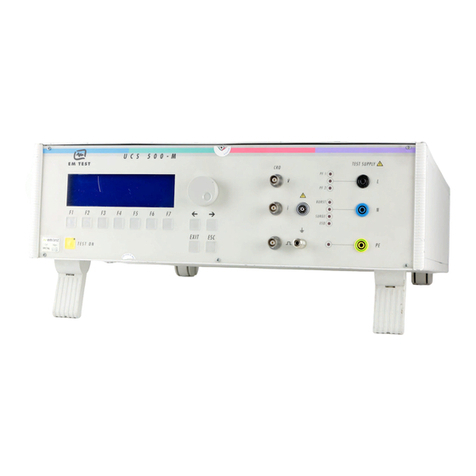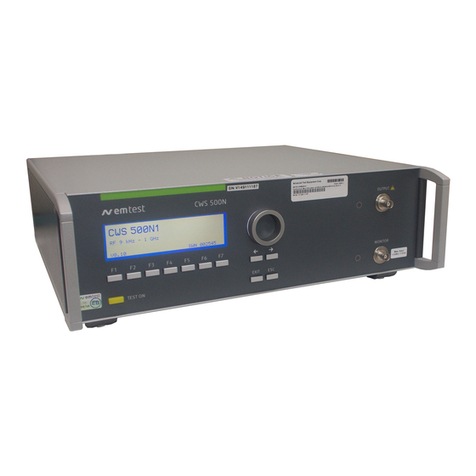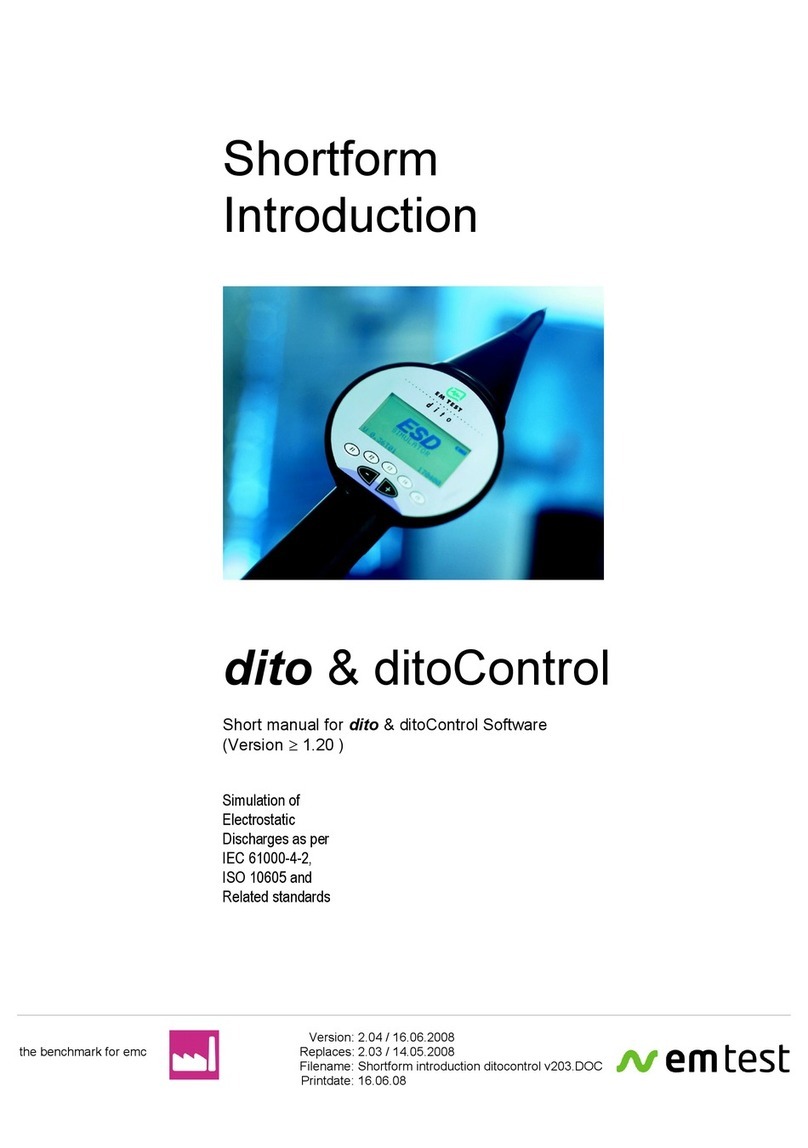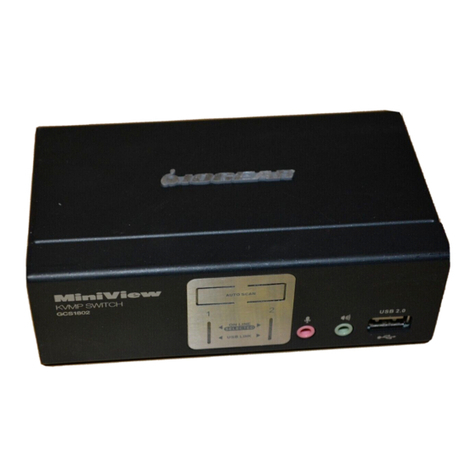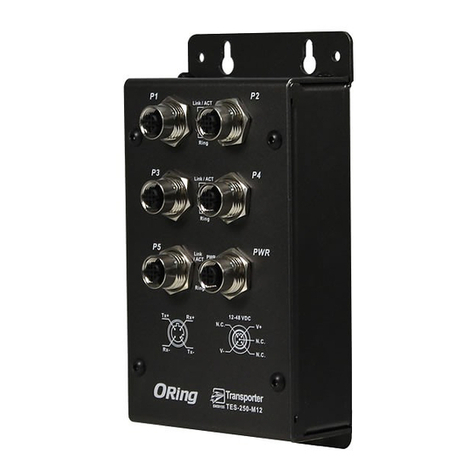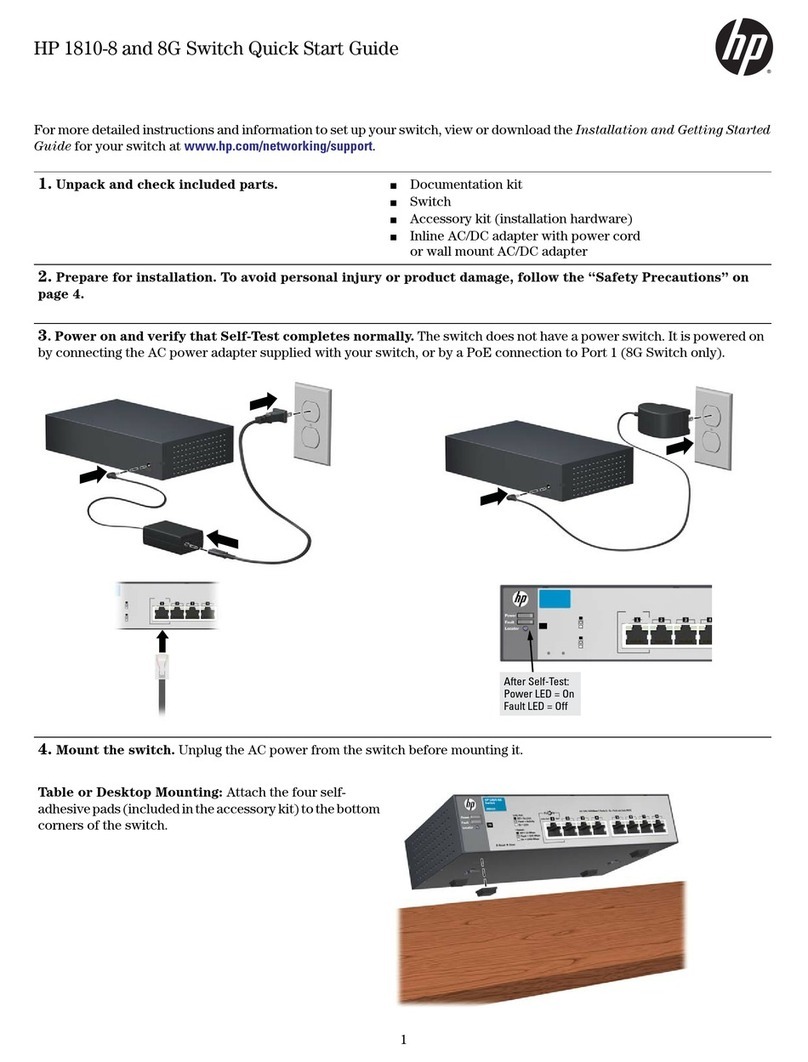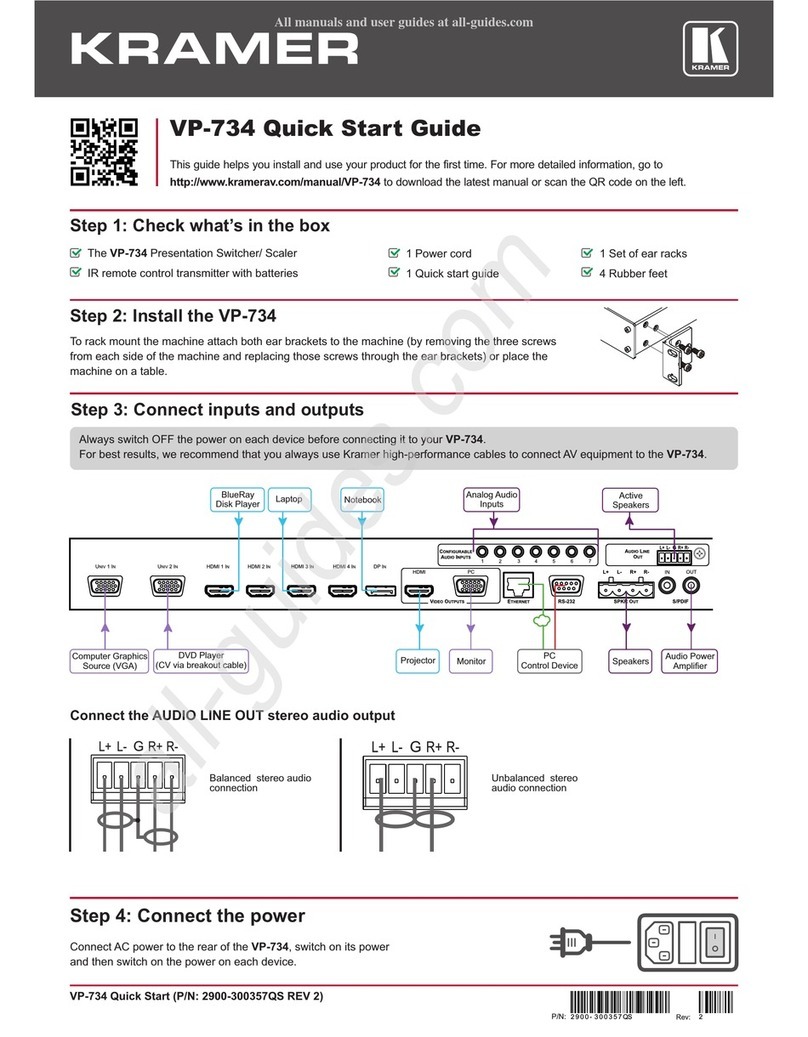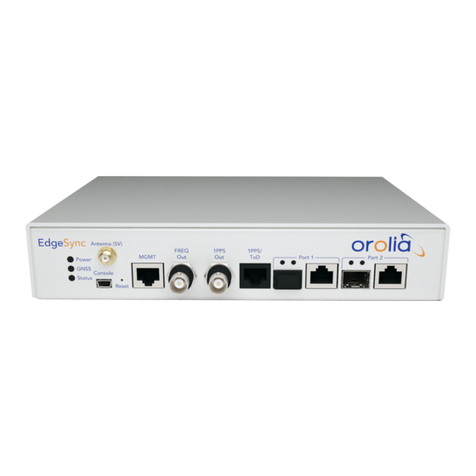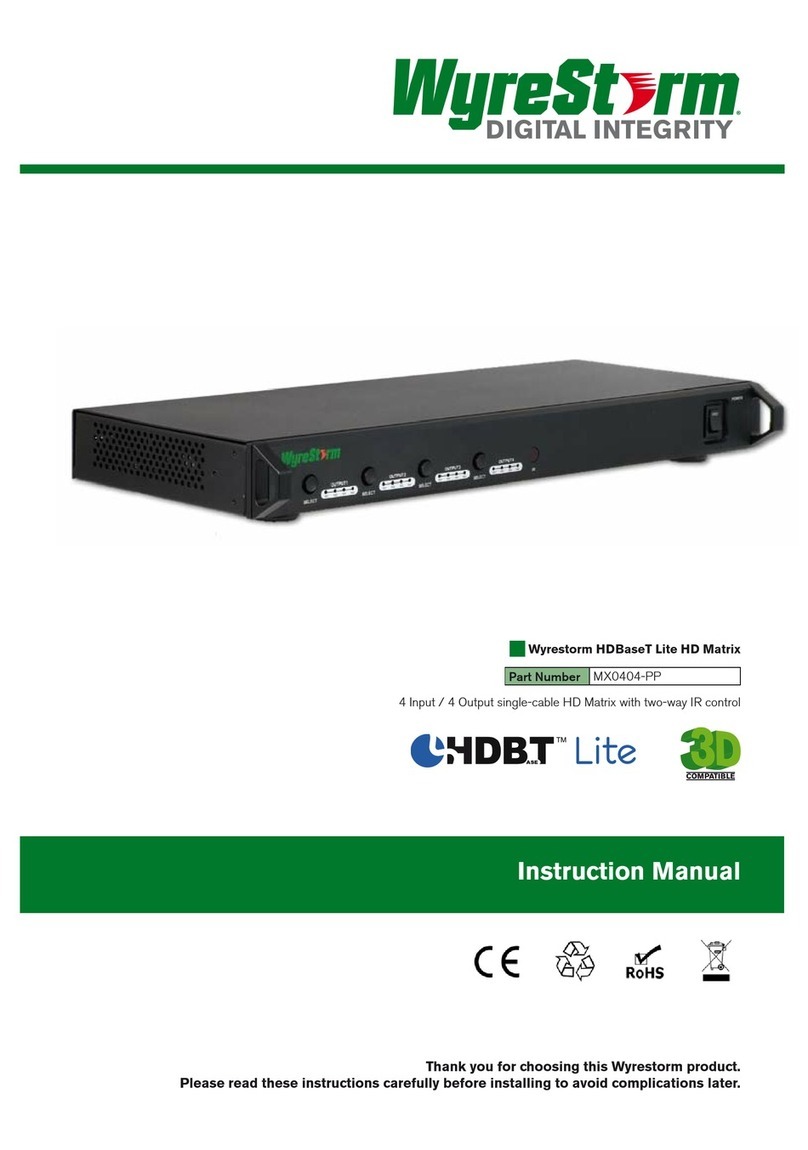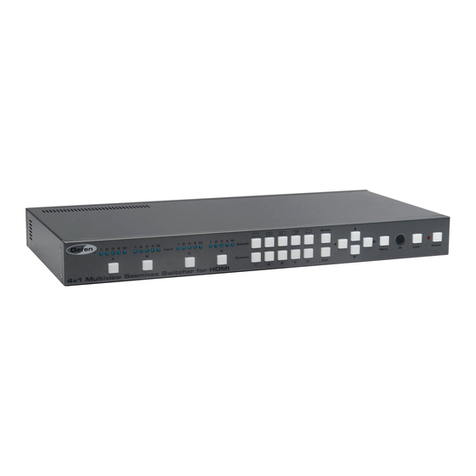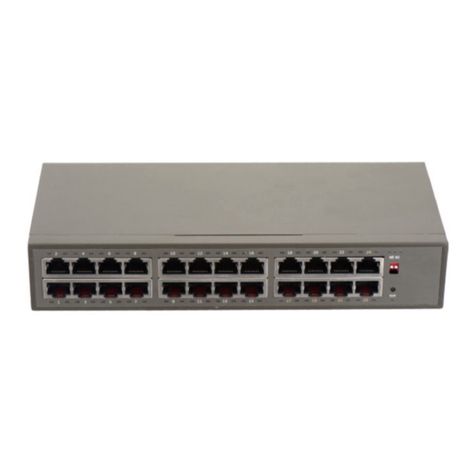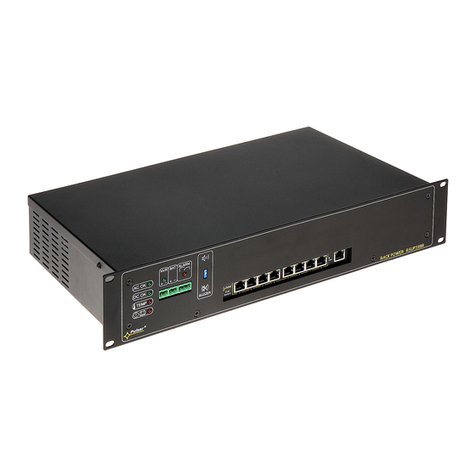EMTEST BS 200N100 User manual

M a n u a l
f o r O p e r a t i o n
BS 200N100
BS 200N100.1
Electronic switch
for Voltage Transient testing
CABS 200N Load impedance for BS200N100
RS-Box Shunt resistor
R-Box LV124
The BS 200N100 is used to evaluate automotive electrical and
electronic components for conducted emissions of transients
along battery fed or switched supply lines of a Device Under
Test (DUT). A device under test which is considered a potential
source of conducted disturbances should be tested according to
ISO 7637 part 2. The BS 200N100 and BS 200N100.1 include
an electronic switch for repeatable switching of inductive loads
as specified in ISO 7637-2:2011 yet supporting former standard
editions.
•ISO 7637-1:1990
•ISO 7637-2:1990
•ISO 7637-2:2004
•ISO 7637-2:2011
Version:
1.12 / 30.08.2019
the benchmark for emc
Replaces:
1.11 / 03.06.2017
Filename:
UserManual-BS200N100-E-V1.12.doc
Printdate:
30.08.19

AMETEK CTS BS 200N100
Operating manual V 1.12 3 / 21
Contents
1. Standards covered by BS 200N100 .............................................................................................................4
1.1. Maximum applicable dc voltage supply ................................................................................................4
2. Operating functions ......................................................................................................................................5
2.1. Operating elements on the top side......................................................................................................5
2.2. Operating elements Front- and Rearside..............................................................................................6
3. Equipment description .................................................................................................................................7
3.1. Electronic switch ...................................................................................................................................7
3.2. Divider 1:200.........................................................................................................................................7
3.3. Air cooling..............................................................................................................................................7
4. Technical Data ...............................................................................................................................................8
4.1. Technical data BS 200N100 .................................................................................................................8
4.2. Technical data CA BS 200N .................................................................................................................9
4.3. Technical data Shunt resistor RS-Box................................................................................................10
4.4. R-Box LV124 Resistor box..................................................................................................................10
5. Calibration / Measuring procedure4..........................................................................................................11
5.1. Test load CABS 200N.........................................................................................................................11
5.2. Test voltage.........................................................................................................................................11
5.3. Switch-Off fall time ..............................................................................................................................11
5.4. Measuring results................................................................................................................................12
5.4.1. Voltage drop in dependence of the test load ......................................................................................12
5.4.2. Measuring results with verification set-up as per Standard ................................................................12
5.4.3. Verification...........................................................................................................................................12
6. Maintenance.................................................................................................................................................13
6.1.General................................................................................................................................................13
6.2. Calibration and Verification.................................................................................................................13
6.2.1. Factory calibration...............................................................................................................................13
6.2.2. Guideline to determine the calibration period of EM Test instrumentation.........................................13
6.2.3. Calibration of Accessories made by passive components only:.........................................................13
6.2.4. Periodically In-house verification.........................................................................................................13
7. Application...................................................................................................................................................14
7.1. Test setup ISO 7637-2 Ed.3 (2011)....................................................................................................14
7.2. LV 124 Test E-10 short interruption Text case 3 ................................................................................16
8. Delivery Groups...........................................................................................................................................17
8.1. Basic equipment..................................................................................................................................17
8.2. Options................................................................................................................................................18
9. Appendix ......................................................................................................................................................19
9.1. Declaration of CE-Conformity .............................................................................................................19
9.2. BS 200N100 - Overview......................................................................................................................20
9.3. CA BS - Overview ...............................................................................................................................21

AMETEK CTS BS 200N100
Operating manual V 1.12 4 / 21
1.
Standards covered by BS 200N100
With the BS 200N100 the user covers the following standards for conducted emission transients:
- ISO 7637-2 Ed3 (2011-03)
Road vehicles; Electrical disturbances by conduction and
coupling ;
Part 2 : Electrical transients conduction along supply lines only
- several standards
In accordance with ISO 7637 Part 2
- LV 124
Elektrische und elektronische Komponenten in Kraftfahrzeugen
bis 3,5t
- Allgemeine Anforderungen, Prüfbedingungen und Prüfungen
1.1.
Maximum applicable dc voltage supply
The maximum applicable DUT dc voltage supply for the BS 200N100 is 60V
DC
Higher dc voltages will damage the equipment.

AMETEK CTS BS 200N100
Operating manual V 1.12 5 / 21
2.
Operating functions
2.1.
Operating elements on the top side
Figure 2.1 : BS 200N100 Top side
1Switch Trigger mode :Manual or Ext. / Auto
2Switch operating mode (normal open / closed)
3LED Switch closed
4Button MANUAL Trigger
5Switch TEST ON / OFF
6Potentiometer Pulse duration 10ms ...>500ms
7Potentiometer Pulse repetition 1s...>5s
1 Trigger Mode
Trigger release selection of the BS 200N100 switch:
MAN / EXT : The trigger is released by manual operation with the button MANUAL, or
via an external trigger signal at the BNC plug EXT.
AUTO : After switch TEST ON button, the BS 200N100 switch starts to work.
2 Switch Mode
Setting of the switch mode:
- NO : (Normally Open) The switch is normally open and close at each event.
- NC : (Normally Closed) The switch is normally closed and opens at each event.
3 LED Switch closed
The LED is lighted during the switch is closed.
4 Manual Trigger
Select “Manual trigger” mode of the switch. (open and closing time depends the time setting)
- OFF : Initial state
–ON : One switch event is released.
5 TEST
On / Off switch for start the electronic switch:
- OFF : Switch out of service (switch status depends on setting NC or NO).
–ON : Switch in operation (open and closing time depends the time setting).
6 Pulse Duration
Potentiometer for adjust the switch duration.
Range: 10ms ... > 500ms ± 5%
7 Pulse Repetition
Potentiometer for adjust the repetition time.
Range: 1s ... > 10s± 5%

AMETEK CTS BS 200N100
Operating manual V 1.12 6 / 21
2.2.
Operating elements Front- and Rearside
Figure 2.2: BS 200N100 view left and right side
1Power IN +
2Input DUT supply -IN
3Monitor DUT output 1:200, 5%
4Trigger OUT (15V neg. slope)
5Trigger IN (Pull down)
6BS200N100 Power supply 24V DC
7Output to DUT +
8Output to DUT -
9Reference earth connection
1 Power IN + supply
The battery supply +IN for the DUT is connected to this input. The switch is located between POWER +IN
and DUT +plug. The nominal dc supply parameters are 60V / 100A .
2 Power IN - supply
The battery supply -IN for the DUT is connected to this input. Internal is a direct connection to DUT- plug.
3 Monitor DUT
Monitor output for voltage measuring (divider 200:1, 5%). The monitor measures the voltage at the DUT
side. The BNC output plug is isolated.
For transient emission measuring an external voltage probe with >400MHz bandwidth must be used.
4 CRO Trigger OUT
Trigger output for an oscilloscope trigger. Trigger with a negative slope (+15V to 0V).
5 Trigger IN
The Trigger IN (Umax. +15V) has two different modes
1. External trigger input for start a single switch event using the duration, setting with the potentiometer.
The trigger shall be a zero going signal (BNC to GND.
2. Direct switch control ON/OFF (LV124 application)
The trigger controls direct the switch. This happens normally with the PFS 200 generator trigger out
signal. For set the BS 200N100 in this mode, the user must press during the power on time the “Manual
Trigger” button. A short LED blinking confirms the correct setting.
6 Power supply device 24V DC
Input plug for 24V dc supply 1A.
7 Output to DUT +
The DUT is connected at the banana output sockets OUT +.
8 Output to DUT -
The DUT is connected at the banana output sockets OUT -.
9 Reference earth connection
The bottom plane is the reference GND of the BS 200N100 and must be connected to the ground reference
plane.

AMETEK CTS BS 200N100
Operating manual V 1.12 7 / 21
3.
Equipment description
The Switch BS 200N100 is designed with the following main components:
- Electronic switch
- Differential Voltage divider 200:1
Figure 3.1. : General diagram BS 200N100
3.1.
Electronic switch
The electronic Switch has 2 operating modes:
NC : Normally Closed
NO : Normally Open
Figure 3.2 shows the both operating modes with the
variable parameters “Repetition“ and “Duration“
The electronic switch disconnects the DUT from battery
supply voltage for a specified time in a well specified and
reproducible manner.
Figure 3.2. : Operating modes Switch BS 200N100
The electronic switch is activated by pushing the button TEST. The red LED indicates the closed status.
In AUTO mode the electronic switch is triggered internally with the preselected repetition rate. In MANUAL mode a
single switching event is triggered either bypushing the MANUAL button or by remote trigger.
The electronic switch can switch currents up to 100A and is able to withstand voltages up to 1000V.
The electronic switch is protected against overload and can withstand short-circuit conditions.
Specific protection requirements of the EUT must be separately assured by the user.
Inrush currents
Inrush currents up to 500A are permitted.
Overvoltage
The switch is protected against over voltages higher than 1000V by internal varistors.
3.2.
Divider 1:200
The built in differential divider is designed to monitor the supply voltage. The measuring signal is available on the
MONITOR BNC plug. The 10MHz bandwidth is not designed for measuring the transient emission. The standard
recommends an external voltage probe for this measurement.
The divider is an ohmic- capacitive differential divider with a 50terminating resistor to the BNC plug.
3.3.
Air cooling
The BS200N100 has internal air ventilation for cooling the battery supply switch. Ventilation grid and
ventilator (blower) must be kept away from other devices in order to allow sufficient air flow through the
battery supply switch.

AMETEK CTS BS 200N100
Operating manual V 1.12 8 / 21
4.
Technical Data
4.1.
Technical data BS 200N100 and BS 200N100.1
Test voltage
Operating voltage
Max. 60 V
Operating current
Max. 100 A continuous
Peak current protection
500 A
Inrush current
400 A for 200 ms
Voltage drop
Less than 0.2 V @ 25 A
Less than 1.2 V @ 100 A
Peak voltage
Typ. 1300 V
Overvoltage protection
By varistor
Overvload protection
short –circuit over temperature protected
switch off after approx. 2 min with 120 A;
switch on after approx.. 45 s cooling time.
Inverse polarity protection
Protected with an additional acoustic signal in case of inverse polarity
Electronic switch
Switching time
300 ns 20% (240 ns –360 ns) into test load 50H/0.6
On/Off duration
Min. 10 ms to 500 ms continuously selectable by potentiometer ± 5%
On/Off repetition
Min. 1 s to 10 s continuously selectable by potentiometer ± 5%
Operation
Switch closed indicated by LED
Output noise
< 400 mV peak, (typical 300 mV)
Trigger
Manual
Manual trigger of a single event
Auto
Automatic trigger with min. 0.1 Hz to max. 1 Hz repetition, continuously
selectable by potentiometer
Extern
External trigger 0V, BNC input (Umax. +15 V)
External LV124 Mode
Active when Manual Trigger button is pressed during “Power ON”
Trigger delay typical
Switch off: approx. 10.5 us
Switch on: approx. 94 ms
Measurement
Voltage monitor
BNC output; differential divider 1:200, 5%; Bandwidth 10 MHz
CRO trigger
BNC output, 0 V
General data
Output connector
50mm above GND plane
Connector DUT
6mm high current connector 100 A, 4 mm safety lab connectors 32 A
Dimensions
90 mm x 125 mm x 120 mm (L x W x H);
Weight
1.30 kg
Supply voltage
24V DC via mains supply adapter

AMETEK CTS BS 200N100
Operating manual V 1.12 9 / 21
Power Supply adapter BS200N100
Model
GE24I24-P1J
Input Voltage
90 → 264V ac
Output Voltage
24V dc
Output Current
1A
Power Rating
24W
Package Plug
Top
Type
Switch Mode
Dimensions
81x43x40.5mm
Efficiency
85%
MTBF
100 khrs
Load Regulation
±3%
Ripple and Noise
240 mV p-p
Line Regulation
±1%
Operating Temperature
-10 → +50°C
Weight
134g
Plug Type
CH/AUS, EURO, UK, USA
ErP Compliance
ErP level V
Number of Outputs
1
4.2.
Technical data CA BS 200N
Test voltage
Battery supply voltage
28Vdc max.
Load current
50A max.
Operating time
13.5V supply approx.1 hour
28.0V supply approx. 10 minutes
Overheat indication
LED
Protection
Switch Off by over temperature sensor
Cooling
Forced air temperature controlled
Impedance
Load
0.6 in series with 50H selectable with bridge (R/L)
Parallel load resistor
10, 20, 40, 120selectable with bridge
General data
Dimensions
19“/ 3HU154 x 448 x 505mm
Weight
18.35 kg
Mains supply
100V to 230V ac 50/60Hz
Fuse
1A slow blow
Cable
2 x 0.45m, red and black 6mm2, each 0.125kg

AMETEK CTS BS 200N100
Operating manual V 1.12 10 / 21
4.3.
Technical data Shunt resistor RS-Box
RS-Box
Resistances
10, 20, 40, 120
Accuracy
<5%
Impedance
Max. EUT voltage
Max. EUT current
Max. power
102040120
30V 30V 50V 60V
3A 1.5A 1.25A 0.5A
90W 45W 62.5W 30W
Cooling
passive
Max Temperature
30V continuous approx. 50deg max.
50V continuous approx. 90deg max.
General data
Dimensions
300 x 105 x 90mm (L x W x H)
Weight
1.70kg
4.4.
R-Box LV124 Resistor box
Resistance
0.1Ω 10kΩ 100kΩ
Max. Spannung
60V 60V 60V
Load at Vmax.
continuous continuous
Max. load
5W 10 min
10W 5 min
General Data
Dimension
150 x 80 x 80mm (L x W x H)
Weight
0.45 kg

AMETEK CTS BS 200N100
Operating manual V 1.12 11 / 21
5.
Calibration / Measuring procedure4
5.1.
Test load CABS 200N
The test impedance CABS 200N, a test load with 0.6 in series with 50 H inductor, is designed for verification the
BS 200N100 acc. ISO 7637-2 standard.
Test load => R (total) = 0,6 in series with
L (total) = 50 H (1 kHz)
Both R and L also include the variations of the cable and
the structure. The parallel capacitywhich cannot be
avoided is approx. 50pF.
Figure 5.1. : Verification setup
Figure 5.2.: Verification setup
5.2.
Test voltage
According to the standard the switch-Off time should be determined under varying test voltages, such as
Va: U1 = 13.5V and U2 = 27V
Consequently, constant currents of 22.5A or 45A must be considered. The resulting energy consumption at the test
load is:
DC Supply
Power 0.6
13.5 V
304 W
27.0 V
1215 W
5.3.
Switch-Off fall time
The switch-Off fall time is specified as follows (90% to 10%):
ISO 7637 (old version < 1992) tf = 200 ... 400ns
ISO 7637-2: 2011 and DIN 40839 part 1 tf = 300ns + 20% specified at 13.5V only
The resulting transients of the BS 200N100 are measured with a 1:200 voltage probe under loaded condition
according the standard. The voltage probe is directlyconnected to the + and –output of the generator.

AMETEK CTS BS 200N100
Operating manual V 1.12 12 / 21
5.4.
Measuring results
5.4.1.
Voltage drop in dependence of the test load
DUT current
Nominal voltage drop
voltage drop
( typical value )
1 A
≤2.0
0.01 V
5 A
≤2.0
0.04 V
10 A
≤2.0
0.07 V
25 A
≤2.0
0.17 V
50 A
not specified
0.35 V
100 A
≤1.0 EM Test specs.
0.96 V
➔Specification values (measured between Power IN+ und DUT+)
5.4.2.
Measuring results with verification set-up as per Standard
All measuring values indicated as well as the curve illustrated have been recorded with a serial model.
Reference values measured with BS 200N100
Input Voltage: 13.5 V
Output Voltage: 13.30 V
Upeak: - 1030 V
tf (90% - 10%): 327.4 ns
Figure 5.3. : Pulse parameter
5.4.3.
Verification
Verification as per ISO 7637-2 Ed3 (2011-03) is defined at 13.5V only. Verification must be performed with
calibration load CABS: 0.6in series with 50H; Rshunt not used
Verification with CABS
Va
output voltage
tf 90% - 10%
fall time
With standard load
+13.5V 10%
300ns 20%
Function
Setting
Switch Mode
NO / NC
Trigger Mode
Man.Ext / Auto
Manual
OFF / ON
Test
OFF / ON
Pulse Repetition
1s
Pulse Duration
10ms
Example for the switch off impulse
Figure 5.4.: Test load at 13.5V

AMETEK CTS BS 200N100
Operating manual V 1.12 13 / 21
6.
Maintenance
6.1.
General
The internal semiconductor switch does not need any maintenance.
6.2.
Calibration and Verification
6.2.1.
Factory calibration
Every EM TEST generator is entirely checked and calibrated as per international standard regulations before
delivery. A calibration certificate is issued and delivered along with a list of the equipment used for the calibration
proving the traceability of the measuring equipment. All auxiliary equipment and accessories are checked to our
internal manufacturer guidelines.
The calibration certificate and the certificate of compliance (if available) show the date of calibration.
The EM Test product is calibrated in the factory and marked with a calibration mark.
The used measuring instruments are traceable to the Swiss Federal Office of
Metrology.
The calibration interval is to the responsibility of the user’s quality system. Neither
the certificate of calibration nor the corresponding label mark any due date for re-
calibration.
Example: Calibration mark
6.2.2.
Guideline to determine the calibration period of EM Test instrumentation
Our International Service Departments and our QA Manager are frequently asked about the calibration interval of
EM TEST equipment.
EM TEST doesn’t know each customer’s Quality Assurance Policy nor do we know how often the equipment is
used and what kind of tests are performed during the life cycle of a test equipment. Only the customer knows all
the details and therefore the customer needs to specify the calibration interval for his test equipment.
In reply to all these questions we like to approach this issue as follows:
EM TEST make use of a solid state semiconductor switch technique to generate high voltage transients. A
precious advantage of this technique is the absolute lack of periodical maintenance effort. In consequence,
thereof a useful calibration period has to be defined based on two criteria:
- The first one is the customer’s Quality Assurance Policy. Any existent internal regulation has to be applied at
highest priority. In the absence of such internal regulation the utilization rate of the test equipment has to be
taken into consideration.
- Based on the experience and observation collected over the years EM TEST recommends a calibration
interval of 1 year for frequently used equipment. A 2-years calibration interval is considered sufficient for
rarely used test generators in order to assure proper performance and compliance to the standard
specifications.
6.2.3.
Calibration of Accessories made by passive components only:
Passive components do not change their technical specification during storage. Consequently, the measured
values and the plots stay valid throughout the storage time. The date of shipment shall be considered as the date
of calibration.
6.2.4.
Periodically In-house verification
Please refer to the corresponding standard before carrying out a calibration or verification. The standard
describes the procedure, the tolerances and the necessary auxiliary means. Suitable calibration adapters are
needed. To compare the verification results, EM Test suggests to refer to the waveshape and values of the
original calibration certificate.

AMETEK CTS BS 200N100
Operating manual V 1.12 14 / 21
7.
Application
7.1.
Test setup ISO 7637-2 Ed.3 (2011)
Important
- The artificial network AN shall be connected directly to the ground reference plane.
- All wires between AN and the DUT shall be isolated from the ground plane by 50mm.
- The DUT will be placed on the ground plane as in real installation.
- directly grounded to the ground plane or
- 50mm isolated from the ground plane
- The position of the instruments shall be as specified in the standard.
Switch as per ISO 7637-2:2011
For the measurement of the emission the ISO 7637-2: 2011 standard defines two different switches and switch
positions. These are pending from the rise time of the voltage impulse. The switch position for slow impulses in
the ms range is before the electrical switch see figure 7.1. For fast impulses, in s and ns range, the switch is on
the DUT side figure 7.2. During the examination, only one switch may be operated.
For the emission measurement ISO 7637-2: 2011 defines the test setup below. EM Test propose the test setup
illustrated in figure 7.1, 7.2 and 7.3.
Figure 7.1.: Setup for pulses in the ms range
Figure 7.2.: Setup for pulses in the s / ns range
Setup for DUT with internal Switch
ISO 7637-2:2011 offers a new test setup as shown in
figure 7.3 for measuring the transient emission using
DUT with internal switch.
This setup is for measuring the transient emission
pulses in ns to us range. Cause the existing original
switch inside the DUT, it is not necessary to use the
BS200N100 in the setup. The shunt resistor Rs is to
use as per clause 5.2 of the ISO 7637-2 standard.
Figure 7.3: Setup for DUT with internal switch for s / ns pulses

AMETEK CTS BS 200N100
Operating manual V 1.12 15 / 21
Electronic Switch for pulses below 400V
Inside the BS 200N100 the electronic switch is built in. A clear determination of a disturbance is possible only if
an electronic switch with reproducible characteristics is used. For the measurement of the pulses under 400V an
electronic switch is recommended (ISO7637-2:2011). The BS200N100 can be used up to 1000V pulses
In order to determine the amplitude and wave shape of a transient, first use the test set-up shown in figure 7.1 for
determine the maximum amplitude of the slower impulses (ms range). In the next procedure use test setup as
shown in figure 7.2 for measure the maximum amplitude of the fast transients.
Switch for voltage impulses higher than 400V special in s / ns range
The switch affects in particular the characteristics of the fast transient ones substantially. Besides gladly high
amplitudes arise with fast pulses, which can be limited by the protection device of the electrical switch. Therefore,
the standard recommends to use the original switch how it is used in the vehicle as switching device for pulses
in s / ns range. If such a device is not available, an automotive relay with the following characteristics shall be
used:
- contact rating, I = 30 A, continuous, resistive load;
- high purity silver contact material;
- no suppression across relay contact;
- single/double position contact electrically insulated from the coil circuit;
- coil with transient suppression.
The switching relay shall be replaced if significant contact degradation occurs.
Resistor Rs
A shunt resistor of 40shall simulate the dc impedance of other connected consumers in the cable tree.
According to ISO/DIN 7637 when measuring transient overvoltage, a shunt resistor of 40is required, whereas
when measuring transient overcurrent, a shunt resistor of 2is required. For this purpose, an external resistor of
2.5 / 400 W (at 30 V DC) respective 40must be connected in the test circuit. (Figures 7.1., 7.3 and 7.3.)

AMETEK CTS BS 200N100
Operating manual V 1.12 16 / 21
7.2.
LV 124 Test E-10 short interruption Text case 3
The LV124 is a cooperated standard of all German car manufacturers. The application note AN 213 describes in
detail the tests with E-10 and E-13. The following chapter describes the test using the BS200N100
EM Test proposal for Test case 3 with 0.1Ω resistor
This proposal is not exact as it is in the LV 124 standard, because the 0.1Ω resistor is only during the interruption
time in the circuit. This disadvantage allows the using of smaller dc sources. It is not necessary to drive a
constant 110A current into the 0.1Ω resistor.
Figure 7.4: EM Test proposal for test setup for test case 3
Test setup and cabling
DUT is connected wired with the PFS200 and BS200N100 as shown in figure 7.4.
Cabling
- + pole (PFS200N) to DUT +
- DUT+ to Power IN+ (BS200N100)
- DUT+ (BS200N100) to Input (R-Box LV124, Box set to 0.1Ω)
- GND (R-Box LV124) to –pole (PFS200)
- DUT-(BS200N100) to –pole (PFS200)
- DUT-to Power IN- (BS200N100)
BNC cable: PFS200 trigger to Trigger IN (BS200N100).
Settings on BS200N100:
Switch Mode: NO Normally Open
Trigger Mode: MAN / Ext.
Duration: Synchronous with trigger signal PFS200 (Power ON BS200N100 as per note below)
Test: ON
Power ON BS200N100: The BS200N100 must work synchronous with the trigger IN signal. For set the
BS200N100 into the LV 124 mode, the user must press the “Manual Trigger” button
during connect the power to the BS 200N100. A short LED blinking with an acoustic
beep confirms the correct LV 124 mode. The potentiometer time setting is disabled in
this mode.
Function BS200N100
The Trigger IN controls the ON / OFF position of the
switch. The trigger signal is generated from the PFS200
power fail generator.
Figure 7.5: R-Box LV124

AMETEK CTS BS 200N100
Operating manual V 1.12 17 / 21
8.
Delivery Groups
8.1.
Basic equipment
•Switch BS 200N100
•Mains cable
•Manual on USB memory stick
•Calibration certificate
Figure 8.1.: BS 200N100
•Mains adapter 24V dc
•Plug Type CH/AUS, EURO, UK, USA
Figure 8.2.: Supply adapter
•4 connection clamps for assembling
•2 connection bridge 6mm BS200N100 to AN 200N100 with
junction 4mm to a load resistor Rs
Figure 8.3 connectors
Identical accessory parts are delivered only once if several devices are ordered. The delivered packing list is in
each case valid for the delivery.

AMETEK CTS BS 200N100
Operating manual V 1.12 18 / 21
8.2.
Options
•CA BS calibration load 50uH 0.6
Delivery : Mains cable
2x connection cable ( 45cm)
2x Short circuit bridges
Figure 8.4. CA BS
•AN 2050N Artificial Network for Automotive
LISN Impedance : As per ISO 7637-2
Impedance : 5H - 50
Current: 50A continuous, 100A short-time
Figure 8.5.: AN 2050N
•AN 200N100 Artificial Network
LISN Impedance : As per ISO 7637-2, ISO 11452-2
CISPR16-1-2, CISPR 25
Impedance :5H - 50
Current: 100A continuous
Figure 8.6.: AN 200N100
•Shunt resistor Rs
Shuntresistor for simulate the resistance of other vehicle
devices which are connected in parallel to the DUT. The
standard ISO 7637-2 defines the shuntresistor Rs.
RS-Box 10Ω, 20Ω, 40Ω, 120Ω max. 60V (30V)
Figure 8.7. RS-Box
•R-Box LV124
Resistor box for LV124 E 10
Resistors: 0.1Ω, 10kΩund 100kΩ
Voltage: 60V continuous for 10kΩ and 100kΩ
Max load 0.1Ω: 5W 10 min, 10W 5 min
Figure 8.8.: R-Box LV124

AMETEK CTS BS 200N100
Operating manual V 1.11 19 / 21
9.
Appendix
9.1.
Declaration of CE-Conformity
Manufacturer:
AMETEK CTS (Switzerland) GmbH
Address:
Sternenhofstr. 15 CH 4153 Reinach
Switzerland
declares, that under is sole responsibility, the product’s listed below, including all their options, are conformity with the
applicable CE directives listed below using the relevant section of the following EC standards and other normative
documents.
Product‘s name:
Switch
Model Number(s)
BS 200N100
BS 200N100.1
CA BS
RS-Box
R-Box LV124
Low Voltage Directive 2014/35/EU
Standard to which conformity is declared:
EN 61010-1: 2011
Safetyrequirements for electrical equipment for measurement, control, and
laboratory use.
EMC Directive 2014/30/EU
Standard(s) to which conformity is declared:
EN 61326-1: 2013
Electrical equipment for measurement, control and laboratory use Class A
EN 61000-3-2: 2014
Limits for harmonic current emissions
EN 61000-3-3: 2013
Limitation of voltage changes, voltage fluctuations and flicker in public low-
voltage supply systems.
European representative
Manufacturer
AMETEK CTS Germany GmbH
AMETEK CTS GmbH
Lünenerstr. 211
Sternenhofstr. 15
D 59174 Kamen
CH 4153 Reinach
Tel: +49 (0) 2307 / 26070-0
Tel: +41 61-7179191
Fax: +49 (0)2307 / 17050
Fax: +41 61-7179199
By
A. Gerstner
General manager
A. Burger
Business Manager Conducted EMC
Place
Kamen, Germany
Reinach BL, Switzerland
Date
1. July 2017
1. July 2017

AMETEK CTS BS 200N100
Operating manual V 1.12 20 / 21
9.2.
BS 200N100 - Overview
Figure 9.1.: Overview BS 200N100
This manual suits for next models
1
Table of contents
Other EMTEST Switch manuals
Popular Switch manuals by other brands

Asante
Asante IntraCore IC3648 Specifications
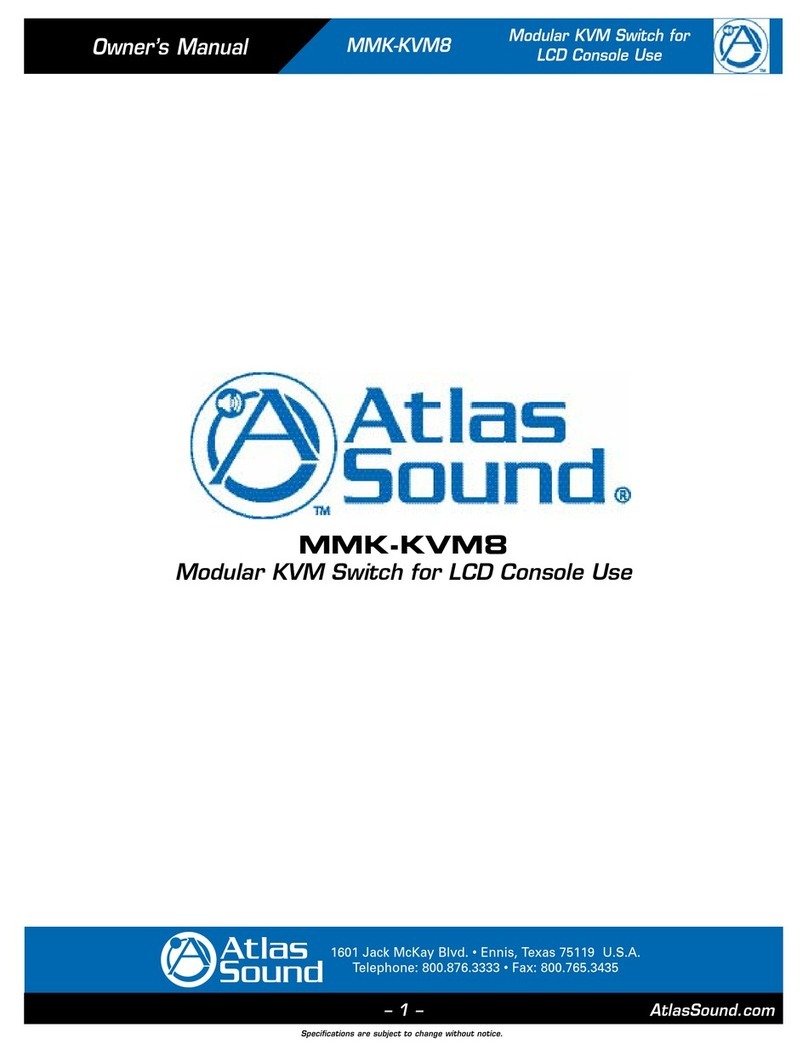
Atlas
Atlas MMK-KVM8 owner's manual

Buhler
Buhler MDS Installation and operation instruction
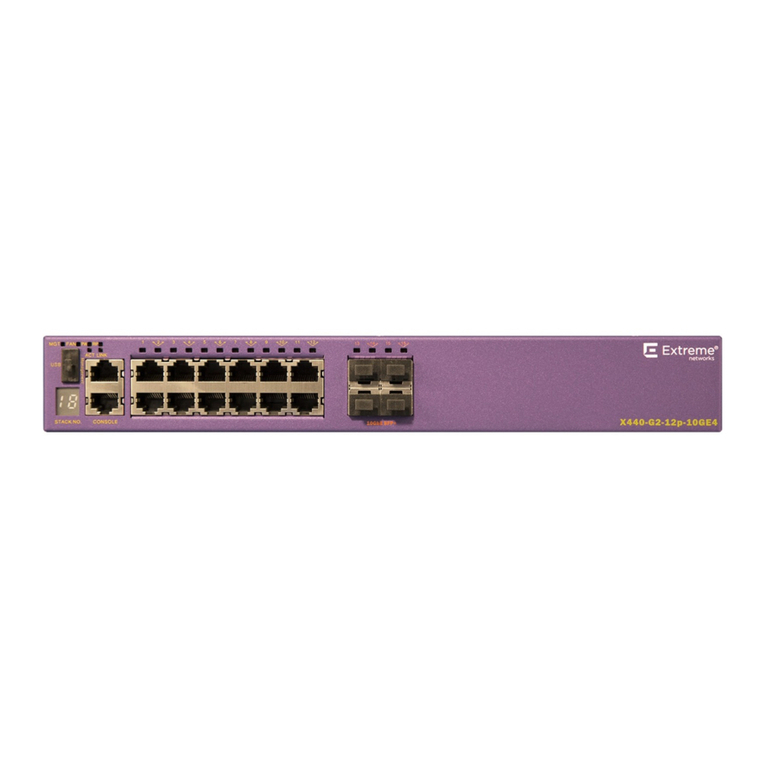
Extreme Networks
Extreme Networks ExtremeSwitching X435 Series Hardware installation guide
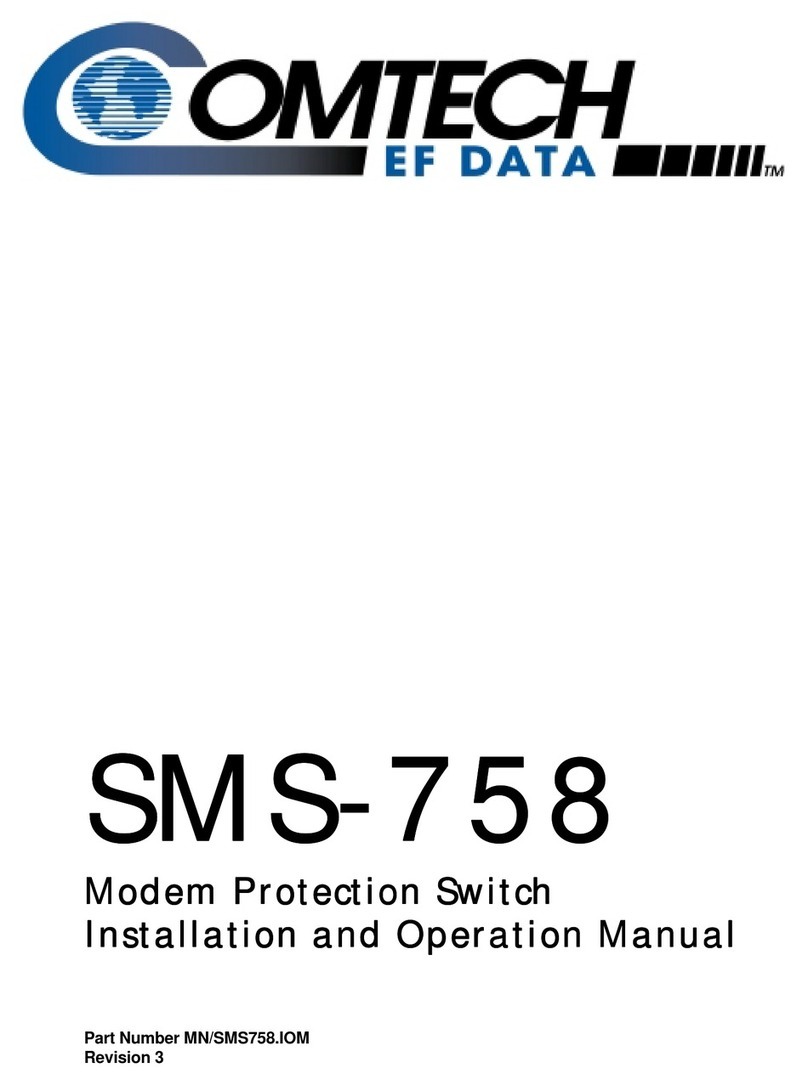
Comtech EF Data
Comtech EF Data SMS-758 Installation and operation manual
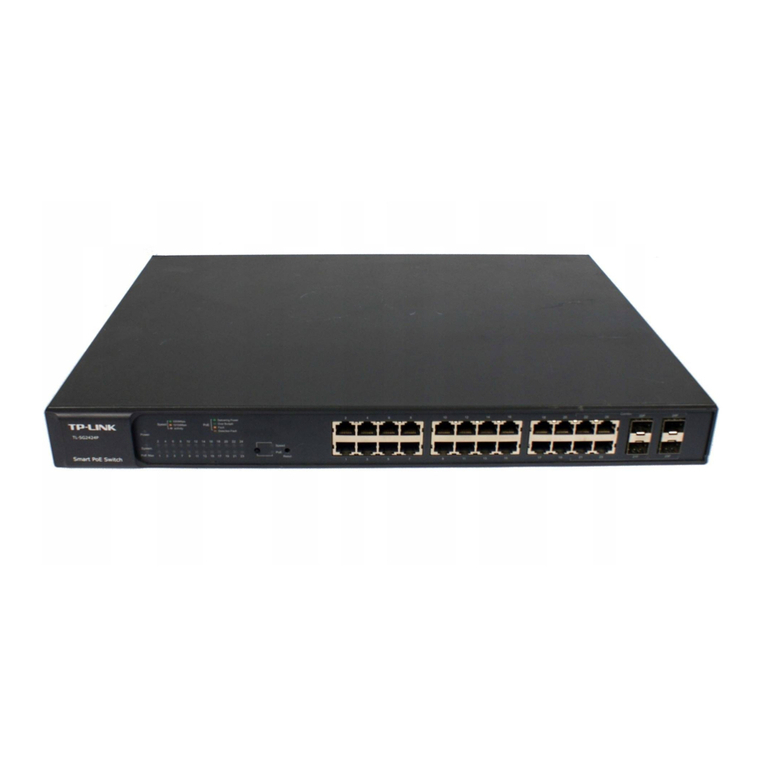
TP-Link
TP-Link TL-SG2424P reference guide


